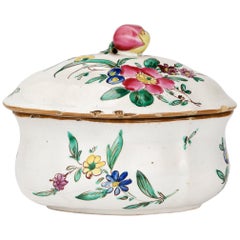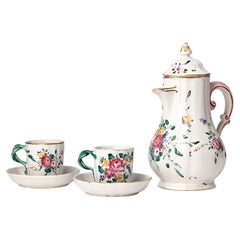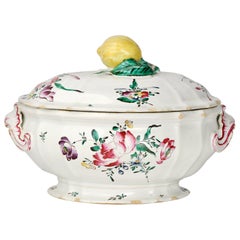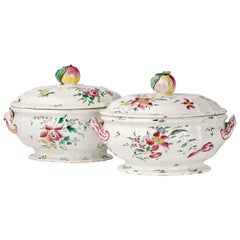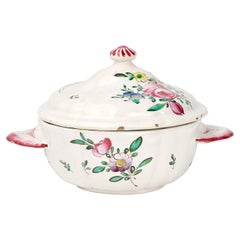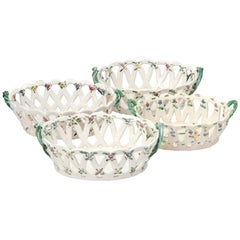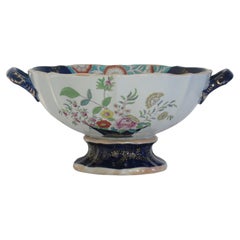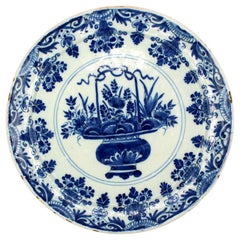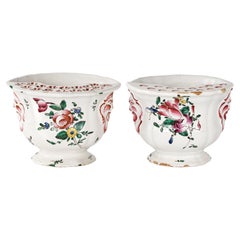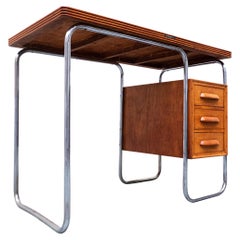Antonio Ferretti Furniture
to
10
10
7
2
1
9
1
1
1
9
9
9
1
1
10
10
10
10
10
8
8,904
3,909
2,531
2,221
Creator: Antonio Ferretti
Italian Maiolica Ancient Sugar Bowl, Lodi, 1770-1780
By Antonio Ferretti
Located in Milano, IT
Maiolica sugar bowl
Antonio Ferretti Manufacture
Lodi, Circa 1770-1780
Maiolica polychrome decorated “a piccolo fuoco” (third fire).
It measures 3.54 x 4.52 x 3.54 in (9 x 11,5 x 9 cm)
Weight: 0.394 lb (0.179 kg)
State of conservation: small and slight chips on the edges.
The small sugar bowl has a swollen and ribbed body resting on a flat base. The cap-shaped lid follows the rib of the container and is topped with a small knob in the shape of a two-colored fruit.
The sugar bowl is painted “a piccolo fuoco” (third fire) with the characteristic floral motif of bunches and isolated semis.
An example which closely corresponds to this one is kept at the Civic Museum in Lodi (G. Gregorietti, Maioliche di Lodi, Milano e Pavia, Catalogo della Mostra, Milano, 1964 n. 137).
This decorative style represented a strong point of the Lodi factory, which established itself thanks to the vivid nature of the colors made possible by the introduction of a new technique perfected by Paul Hannong in Strasbourg and later introduced by Antonio Ferretti to Italy. The production process, called “piccolo fuoco” (third fire), allowed the use of a greater number of colors than in the past; in particular, the purple of Cassius, a red made from gold chloride, was introduced. Its use allowed for many more tones and shades, from pink to purple.
The Ferretti family started their maiolica manufacturing business in Lodi in 1725.
The forefather Simpliciano started the business by purchasing an ancient furnace in 1725 and, indeed, we have evidence of the full activity of the furnaces starting from April of the same year (Novasconi-Ferrari-Corvi, 1964, p. 26 n. 4). Simpliciano started a production of excellence also thanks to the ownership of clay quarries in Stradella, not far from Pavia. The production was so successful that in 1726 a decree of the Turin Chamber came to prohibit the importation of foreign ceramics, especially from Lodi, to protect internal production (G. Lise, La ceramica a Lodi, Lodi 1981, p. 59).
In its initial stages, the manufacture produced maolicas painted with the “a gran fuoco” (double fire) technique, often in turquoise monochrome, with ornamentation derived from compositional modules in vogue in Rouen in France. This was also thanks to the collaboration of painters like Giorgio Giacinto Rossetti, who placed his name on the best specimens next to the initials of the factory.
In 1748 Simpliciano made his will (Gelmini, 1995, p. 30) appointing his son Giuseppe Antonio (known as Antonio) as universal heir. After 1750, when Simpliciano passed away, Antonio was directly involved in the maiolica factory, increasing its fortunes and achieving a reputation on a European level. Particularly important was the aforementioned introduction in 1760 of the innovative “a piccolo fuoco” (third fire) processing, which, expanding the ornamental repertoire with Saxon-inspired floral themes, was able to commercially compete with the German porcelains that had one of its most renowned offerings in the naturalistic Deutsche Blumen. Antonio Ferretti understood and promoted this technique and this decoration, proposing it in a fresher and more corrective version, less linked to botanical tables, both with or without contour lines, as well as in purple or green monochrome. After efforts to introduce more industrial production techniques to the sector succeeded, even the Ferretti manufacture, in the last decade of the eighteenth century, started heading towards decline despite its attempts to adapt production to neoclassical tastes.
In 1796 the Napoleonic battle for the conquest of the Lodi bridge over the Adda definitively compromised the furnaces. Production resumed, albeit in a rather stunted manner, until Antonio's death on 29 December 1810. (M. L. Gelmini, pp. 28-30, 38, 43 sgg., 130-136 (for Simpliciano); pp. 31 sgg., 45-47, 142-192 (for Antonio).
Bibliography
G. Gregorietti, Maioliche di Lodi Milano e Pavia Catalogo della Mostra, Milano, 1964 n. 137;
C. Baroni, Storia delle ceramiche nel Lodigiano, in Archivio storico per la città e i comuni del circondario e della diocesi di Lodi, XXXIV (1915), pp. 118, 124, 142; XXXV (1916), pp. 5-8;
C. Baroni, La maiolica antica di Lodi, in Archivio storico lombardo, LVIII (1931), pp. 453-455;
L. Ciboldi, La maiolica lodigiana, in Archivio storico lodigiano, LXXX (1953), pp. 25 sgg.;
S. Levy, Maioliche settecentesche lombarde e venete, Milano 1962, pp. 17 sgg.;
A. Novasconi - S. Ferrari - S. Corvi, La ceramica lodigiana, Lodi 1964, ad Indicem; Maioliche di Lodi, Milano e Pavia (catal.), Milano 1964, p. 17;
O. Ferrari - G. Scavizzi, Maioliche italiane del Seicento e del Settecento, Milano 1965, pp. 26 sgg.;
G. C. Sciolla, Lodi. Museo civico, Bologna 1977, pp. 69-85 passim; G. Lise, La ceramica a Lodi, Lodi 1981;
M. Vitali, in Storia dell'arte ceramica...
Category
1770s Italian Rococo Antique Antonio Ferretti Furniture
Materials
Maiolica
Ancient Italian Assortment Coffe Pot and Cups, Lodi, Circa 1765-1770
By Antonio Ferretti
Located in Milano, IT
A coffee pot and two cups with saucers
Antonio Ferretti Manufacture
Lodi, Circa 1765-1770
Maiolica polychrome decorated “a piccolo fuoco” (third fire).
They measure:
coffee pot: 9....
Category
1760s Italian Rococo Antique Antonio Ferretti Furniture
Materials
Maiolica
Italian Maiolica Ancient Tureen, Lodi, 1770-1780
By Antonio Ferretti
Located in Milano, IT
Maiolica tureen
Antonio Ferretti Manufacture
Lodi, circa 1770-1780
Maiolica polychrome decorated “a piccolo fuoco” (third fire).
It measures 9.05 x 12.59 x 9.05 in (23 x 32 x 23 cm)
...
Category
1770s Italian Rococo Antique Antonio Ferretti Furniture
Materials
Maiolica
Pair of Italian Maiolica Tureens, Ferretti Manufacture, Lodi Circa 1770 - 1780
By Antonio Ferretti
Located in Milano, IT
Pair of maiolica tureens
Antonio Ferretti Manufacture
Lodi, circa 1770-1780
Maiolica polychrome decorated “a piccolo fuoco” (third fire).
a – 8.66 x 11.02 x 7.48 in (22 x 28 x 19...
Category
1770s Italian Rococo Antique Antonio Ferretti Furniture
Materials
Maiolica
Italian Maiolica Cup Ferretti Lodi, circa 1770 - 1780
By Antonio Ferretti
Located in Milano, IT
Maiolica puerperal cup
Antonio Ferretti Manufacture
Lodi, Circa 1770 - 1780
Maiolica polychrome decorated “a piccolo fuoco” (third fire).
It measures: 4.3 x 6.8 x 5.3 in (11 x 17,5 x 13,5 cm)
Weight: 0.78 lb (358 g)
State of conservation: some closed pass-through fêlures on the cup, barely visible on the outside. Some use chips on the edge of the lid, two of which are more marked.
From about the mid-sixteenth century, the puerperal soup tureen or puerperal cup became one of the most popular wedding gifts in central Italy. As an auspicious symbol, it replaced the birth table (“desco da parto”) which, on the occasion of high-ranking marriages, from the thirteenth century, had been painted by famous artists, especially in Tuscany.
In France this same tureen is called "écuelle de mariée", as it is given to spouses as a sign of fertility.
During the eighteenth century this custom spread even outside Italy to all social levels. Depending on availability and rank, it was made of different materials: precious metals, maiolica, porcelain, glass, pewter, etc.
Beginning in the mid-twentieth century, the custom of this symbolic homage gradually disappeared, although famous designers such as Gio Ponti and Giuseppe Gariboldi, even as recently as the 1940s, revisited a model of a small puerperal soup bowl for the Ginori and, also in Italy in 1940, in a national competition for young potters, one of the themes of the test was indeed a modern model of a puerperal cup as an auspicious gift.
This particular cup was also called a "service cup" or "puerperal vase" or "stuffed cup" - the windows were sealed with straw to prevent drafts of air for women in labor.
In the eighteenth century the line of the puerpera cup was simplified, so much so that it took the form of a small tureen with two handles - the typical broth cup...
Category
1770s Italian Rococo Antique Antonio Ferretti Furniture
Materials
Maiolica
Two Pairs of Italian Maiolica Baskets, circa 1780
By Antonio Ferretti
Located in Milano, IT
Two pairs of maiolica baskets
Antonio Ferretti Manufacture
Lodi, circa 1770-1790
Maiolica polychrome decorated “a piccolo fuoco” (third fire).
Measures: A) Height 3.54 x 6.69 x 9.84 in (9 x 17 x 25 cm);
B) Height 3.93 x 7.48 x 11.02 in (10 x 19 x 28 cm).
Total weight 4.85 lb (2.200 kg)
State of conservation:
A) One of the smaller baskets has some areas of restoration, the other slight chipping from use;
B) One of the larger baskets is intact and the other shows a clearly glued break.
The mold with which the baskets were forged simulates a wicker weave.
The two larger works have high, vertical walls, with branch-shaped handles penetrating the weave. The painted decorations, small polychrome flowers applied only externally, highlight the points where the weaves intersect.
The decision to leave the center of the basket devoid of decoration is highly unusual, but given the size and complexity of the shape, as well as the quality of the enamel, it is possible to hypothesize that it represents a precise choice in manufacturing or for a particular client.
The two smaller baskets have small, twisted handles and, on the outside, reproduce more decisively the characteristic wicker weave, obtained through thin molded lines. The interior exhibits a rich, typical decoration of naturalistic flowers: a bunch centered around a main flower and secondary stems accompanied by small “semis”. The exterior of these works is also adorned with small little flowers where the weaves intersect.
The size and morphological characteristics of the baskets confirm their attribution to the Lodi factory of Antonio Ferretti between 1770 and 1790, during its most successful period; by this point his original reworking of the "Strasbourg" decoration, known as "old Lodi", had achieved great fame even outside Italy.
This decorative choice represented a strong point of the Lodi factory, which established itself thanks to the vivid nature of the colors made possible by the introduction of a new technique perfected by Paul Hannong in Strasbourg and which Antonio Ferretti introduced in Italy. This production process, called “piccolo fuoco” (third fire), allowed the use of a greater number of colors than in the past; in particular, the purple of Cassius, a red made from gold chloride, was introduced. Its use allowed for many more tones and shades, from pink to purple.
The Ferretti family had started their maiolica manufacturing business in Lodi in 1725.
The forefather Simpliciano had started the business by purchasing an ancient furnace in 1725 and, indeed, we have evidence of the full activity of the furnaces from April of the same year (Novasconi-Ferrari-Corvi, 1964, p. 26 n. 4). Simpliciano had started a production of excellence also thanks to the ownership of clay quarries in Stradella, not far from Pavia. The production was so successful that in 1726 a decree of the Turin Chamber came to prohibit the importation of foreign ceramics, especially from Lodi, to protect internal production (G. Lise, La ceramica a Lodi, Lodi 1981, p. 59).
In its initial stages, the manufacture produced maolicas painted with the “a gran fuoco” (double fire) technique, often in turquoise monochrome, with ornamentation derived from compositional modules in vogue in Rouen in France. This was also thanks to the collaboration of painters like Giorgio Giacinto Rossetti, who placed his name on the best specimens next to the initials of the factory.
In 1748 Simpliciano made his will (Gelmini, 1995, p. 30) appointing his son Giuseppe Antonio (known as Antonio) as universal heir. After 1750, when Simpliciano passed away, Antonio was directly involved in the maiolica factory, increasing its fortunes and achieving a reputation on a European level. Particularly important was the aforementioned introduction in 1760 of the innovative “a piccolo fuoco” (third fire) processing, which, expanding the ornamental repertoire with Saxon-inspired floral themes, could commercially compete with the German porcelains that had one of its most renowned offerings in the naturalistic Deutsche Blumen. Antonio Ferretti understood and promoted this technique and this decoration, proposing it in a fresher and more corrective version, less linked to botanical tables...
Category
1770s Italian Neoclassical Antique Antonio Ferretti Furniture
Materials
Maiolica
Italian 1960s Rotating Desk Document Holder by Antonio Ferretti
By Antonio Ferretti
Located in Milan, IT
Italian 1960s Interchangeable and Rotating Desk Document Holder by Antonio Ferretti.
Antonio Ferretti is one of Italy's earliest Office Supply company.
Category
1960s Italian Mid-Century Modern Vintage Antonio Ferretti Furniture
Materials
Metal, Chrome
Italian Maiolica Pitcher, Ferretti Manufacture, Lodi Circa 1770 - 1780
By Antonio Ferretti
Located in Milano, IT
Maiolica pitcher
Antonio Ferretti Manufacture
Lodi, circa 1770-1780
Maiolica polychrome decorated “a piccolo fuoco” (third fire).
It measures 8.66 x 8.66 x 4.33 in (22 x 22 x 11 ...
Category
1770s Italian Rococo Antique Antonio Ferretti Furniture
Materials
Maiolica
Four Italian Ancient Dishes, Antonio Ferretti, Lodi, circa 1770-1780
By Antonio Ferretti
Located in Milano, IT
Assortment of 4 dishes with braided rim
Antonio Ferretti Manufacture
Lodi, circa 1770-1780
Maiolica polychrome decorated “a piccolo fuoco” (third fire).
Measures: 14 x 10 in (35.5 x 25.5 cm);
12.2 x 8.39 in (31 x 21.3 cm);
10.4 x 9.65 in (26.5 x 24.5 cm);
10.8 x 9.61 in (27.5 x 24.4 cm).
Weight: 4.4 lb (1.998 kg)
State of conservation: some chips due to use on the edges and on the parts in relief.
The four different dishes have a foot with a low lip from which extends a wide, flat, slanted rim resembling a basket weave. The small handles are painted green: they resemble wickerwork in the two oval dishes and take the form of a sinuous branch in the round ones.
The third fire decoration is inspired by the naturalistic floral botanical patterns on the ceramics produced by the Hannong family in Strasbourg. Here the pattern is defined by the rapidity and subtlety of the brushstrokes and the result is particularly tasteful, characterized by compositional intelligence and pictorial expertise.
A main corolla, either a wild or garden rose, is set slightly off center in each well. From this extends a thin stem holding a small secondary bud and there are small field florets dotting the composition to lend volume to the delicate bunch of flowers.
On the brim, small polychrome flowers add color to the weave, accompanied by lanceolate leaves of a very intense green.
There exist few and very rare examples for comparison with this morphology: a round plate - entirely consistent with those in question - has been dated to around 1775 (S. Levy, Maioliche settecentesche lombarde e venete, Milano 1962, tav. 200). Two other dishes with a basket rim, but with parallel striped brim decoration, were exhibited in the 1995 exhibition on Lodi ceramics; the attribution to the Lombard town near Milan is therefore almost exclusively derived from the decoration called "alla rosa contornata" or "alla vecchia Lodi" and constitutes one of the most popular decorations during the eighteenth century. (M. L. Gelmini, in Maioliche lodigiane del '700 (cat. mostra Lodi), Milano 1995, pp. 31 p. 162-163 nn. 181-182).
This decorative choice represented a strong point of the Lodi factory, which established itself thanks to the vivid nature of the colors made possible by the introduction of a new technique perfected by Paul Hannong in Strasbourg and which Antonio Ferretti introduced in Italy. This production process, called “piccolo fuoco” (third fire), allowed the use of a greater number of colors than in the past; in particular, the purple of Cassius, a red made from gold chloride, was introduced. Its use allowed for many more tones and shades, from pink to purple.
The Ferretti family had started their Maiolica manufacturing business in Lodi in 1725.
The forefather Simpliciano had started the business by purchasing an ancient furnace in 1725 and, indeed, we have evidence of the full activity of the furnaces from April of the same year (Novasconi-Ferrari-Corvi, 1964, p. 26 n. 4). Simpliciano had started a production of excellence also thanks to the ownership of clay quarries in Stradella, not far from Pavia. The production was so successful that in 1726 a decree of the Turin Chamber came to prohibit the importation of foreign ceramics, especially from Lodi, to protect internal production (G. Lise, La ceramica a Lodi, Lodi 1981, p. 59).
In its initial stages, the manufacture produced maolicas painted with the “a gran fuoco” (double fire) technique, often in turquoise monochrome, with ornamentation derived from compositional modules in vogue in Rouen in France. This was also thanks to the collaboration of painters like Giorgio Giacinto Rossetti, who placed his name on the best specimens next to the initials of the factory.
In 1748 Simpliciano made his will (Gelmini, 1995, p. 30) appointing his son Giuseppe Antonio (known as Antonio) as universal heir. After 1750, when Simpliciano passed away, Antonio was directly involved in the Maiolica factory, increasing its fortunes and achieving a reputation on a European level. Particularly important was the aforementioned introduction in 1760 of the innovative “a piccolo fuoco” (third fire) processing, which, expanding the ornamental repertoire with Saxon-inspired floral themes, could commercially compete with the German porcelains that had one of its most renowned offerings in the naturalistic Deutsche Blumen. Antonio Ferretti understood and promoted this technique and this decoration, proposing it in a fresher and more corrective version, less linked to botanical tables...
Category
1770s Italian Neoclassical Antique Antonio Ferretti Furniture
Materials
Maiolica
Small Maiolica Flower Pots, Ferretti Manufacture, Lodi, circa 1770-1780
By Antonio Ferretti
Located in Milano, IT
Two maiolica flower pots
Antonio Ferretti Manufacture
Lodi, Circa 1770 - 1780
Maiolica polychrome decorated “a piccolo fuoco” (third fire)
The...
Category
1770s Italian Rococo Antique Antonio Ferretti Furniture
Materials
Maiolica
Related Items
Large Masons Ironstone Punch Bowl in Curled Leaf & Flower Basket ptn, circa 1838
By Mason's Ironstone
Located in Lincoln, Lincolnshire
This is a Large twin Handled open Punch Bowl made by Mason's Ironstone in a beautiful pattern called: Curled Leaf and flower Basket, made in the early 19th century, William 1Vth peri...
Category
Early 19th Century English William IV Antique Antonio Ferretti Furniture
Materials
Ironstone
$630 Sale Price
51% Off
H 6 in W 12.75 in D 10.25 in
Circa 1770 Delft Blue & White Plate
Located in Chapel Hill, NC
Circa 1770 Delft blue & white plate. Central handled & footed basket vase overflowing with flowers, surrounded by alternating repetive floral vases & natura...
Category
1770s Dutch Antique Antonio Ferretti Furniture
Materials
Ceramic
Vintage Large Italian Porcelain Duck Tureen
Located in West Palm Beach, FL
Hand painted Italian Porcelain Duck Tureen. A very fine piece that will make your table special.
Category
20th Century Italian Antonio Ferretti Furniture
Materials
Porcelain
Majolica Doe Tureen Caugant, circa 1950
By Michel Caugant
Located in Austin, TX
Rare Majolica doe tureen signed Caugant, circa 1950.
Category
1950s French Country Vintage Antonio Ferretti Furniture
Materials
Ceramic
Italian Neo-Classical Grand Tour Style Ram’s Head Stirrup Cup
Located in Kennesaw, GA
This is an Italian neo-classical Grand Tour ram’s head form stirrup cup. The composition is pottery with an almost bisque-like finish.
Category
Mid-20th Century Italian Neoclassical Antonio Ferretti Furniture
Materials
Pottery
Majolica Brown Rabbit Tureen Caugant
By Michel Caugant
Located in Austin, TX
French Majolica rabbit tureen signed Caugant, circa 1940.
Category
1950s French Country Vintage Antonio Ferretti Furniture
Materials
Ceramic, Faience, Majolica
Rock Handmade Pottery Cereal/Soup Bowls - Set of 2 - Black & White Splatterware
By OWO Ceramics
Located in Ciudad Autónoma de Buenos Aires, AR
Beautiful breakfast handmade ceramic bowls carefully crafted to meet the demands of everyday use.
Designed to enrich your table setting and daily rituals, these handmade pottery bowls blur the line between functionality and ornament. Their size makes it perfect for serving cereals, fruits, snacks, soups or dips.
Sold as a set of two, each pottery bowl is meticulously crafted by hand and coated in a matte glaze featuring hand-painted black splatters that evoke Pollock’s artistic work.
Due to the handcrafted nature, each ceramic bowl is one-of-a-kind, and hand washing is recommended.
Try combining them with our dipping and salad bowls from the Rock Collection to create your own unique handcrafted ceramic splatterware set...
Category
2010s South American Modern Antonio Ferretti Furniture
Materials
Ceramic, Clay, Pottery
$238 / item
H 2.75 in Dm 6.06 in
Italian solid silver 800's tureen in baroque style
By Arval Argenti Valenza
Located in VALENZA, IT
Baroque style oval tureen, made entirely by hand.
The baroque style of this tureen is very light with grooves typical of the style but not evident to allow the object to be easily pl...
Category
2010s Italian Baroque Antonio Ferretti Furniture
Materials
Silver
$2,940 Sale Price
20% Off
H 7.49 in W 12.21 in D 8.08 in
Majolica Brown Rabbit Tureen Caugant
By Michel Caugant
Located in Austin, TX
French Majolica rabbit tureen signed Caugant, circa 1940.
Category
1950s French Country Vintage Antonio Ferretti Furniture
Materials
Ceramic, Faience, Majolica
Italian Majolica Duck or Goose Cabbage and Cauliflower Tureen with Lid and Ladle
Located in Oklahoma City, OK
A hand-painted Italian majolica cabbageware or lettuceware bird and cauliflower tureen with lid and ladle. This petite ceramic serving dish will be ...
Category
20th Century Italian Mid-Century Modern Antonio Ferretti Furniture
Materials
Ceramic, Paint
$440 Sale Price
20% Off
H 6.5 in W 8.5 in D 4.5 in
Handmade Rock Ceramic Salad Bowl - Black & White Splatterware
By OWO Ceramics
Located in Ciudad Autónoma de Buenos Aires, AR
Fantastic handmade salad serving bowl. The perfect piece for making a bold statement, this large ceramic salad bowl is great for functional use or as beautiful decoration in your home. Use it for serving your favorite salads, keeping your weekly fruits out on the counter or as decorative centerpiece bowl.
Each serving bowl is glazed by hand in a matte glaze with hand painted black splatters that resemble Pollock’s artistic work.
Because of their handcrafted nature, all salad bowls are one-of-a-kind and hand washing is recommended.
Try combining it with our dipping and cereal bowls from the Rock Collection to create your own unique handcrafted splatterware set...
Category
2010s Argentine Modern Antonio Ferretti Furniture
Materials
Ceramic, Clay, Pottery
Georgian Mason's Ironstone Dish or Plate in Bamboo & Basket Pattern, circa 1817
By Mason's Ironstone
Located in Lincoln, Lincolnshire
This is a very decorative dish or plate by Mason's Ironstone, Lane Delph, England in the Bamboo and Basket pattern, dating to the early 19th century, Georgian period, circa 1813-1820.
The plate or dish is fairly deep and circular in shape with a notched rim.
It is decorated in one of Mason's boldly colored chinoiserie...
Category
Early 19th Century English Chinoiserie Antique Antonio Ferretti Furniture
Materials
Ironstone
$263 Sale Price
20% Off
H 1.15 in Dm 8.07 in
Previously Available Items
Pair of Italian Maiolica Flower Pots, Antonio Ferretti, Lodi, circa 1770 – 1780
By Antonio Ferretti
Located in Milano, IT
Pair of flower pots
Antonio Ferretti Manufacture
Lodi, circa 1770 – 1780
Maiolica polychrome decorated “a piccolo fuoco” (third fire)
They meas...
Category
1770s Italian Rococo Antique Antonio Ferretti Furniture
Materials
Maiolica
H 4.73 in W 6.7 in D 5.71 in
Mid-Century Modern Small Wooden Italian Desk by Antonio Ferretti, 1950s
By Antonio Ferretti
Located in Brussels, BE
Mid-Century Modern small wooden Italian desk by Antonio Ferretti, 1950s.
Category
1950s Italian Mid-Century Modern Vintage Antonio Ferretti Furniture
Materials
Wood
H 31.3 in W 41.74 in D 22.45 in
Italian Ancient Maiolica Tureen, Lodi, 1770-1780
By Antonio Ferretti
Located in Milano, IT
Maiolica tureen
Antonio Ferretti Manufacture
Lodi, Circa 1770 - 1780
Maiolica polychrome decorated “a piccolo fuoco” (third fire).
It measures 7.48 x 7.48 x 11.02 in (19 x 19 x 2...
Category
1770s Italian Rococo Antique Antonio Ferretti Furniture
Materials
Maiolica
Maple Desk by Antonio Ferretti Milano , Italy, 1940s
By Antonio Ferretti
Located in Sofia, BG
A maple veneered desk, manufactured in Italy by Antonio Ferretti Milan , 1940s.
A beautiful leather green top.
INTERNATIONAL SHIPPING
Our transportation of antique furniture and it...
Category
1940s Italian Mid-Century Modern Vintage Antonio Ferretti Furniture
Materials
Wood
Antonio Ferretti Italian Illustrated Gold Leaf Armoire
By Antonio Ferretti
Located in North York, ON
This Antonio Ferreti armoire is a true showstopper! The front is adorned with a gold leaf façade, complete with illustrated black bamboo shoots. The interior is divided into compart...
Category
1960s Italian Vintage Antonio Ferretti Furniture
Materials
Brass, Gold Leaf
Antonio Ferretti furniture for sale on 1stDibs.
Antonio Ferretti furniture are available for sale on 1stDibs. These distinctive items are frequently made of maiolica and are designed with extraordinary care. There are many options to choose from in our collection of Antonio Ferretti furniture, although beige editions of this piece are particularly popular. Many of the original furniture by Antonio Ferretti were created in the Rococo style in italy during the 18th century and earlier. If you’re looking for additional options, many customers also consider furniture by Pasquale Rubati, Capo Di Monte, and Ilario Pradella. Prices for Antonio Ferretti furniture can differ depending upon size, time period and other attributes — on 1stDibs, these items begin at $885 and can go as high as $12,802, while a piece like these, on average, fetch $3,558.
